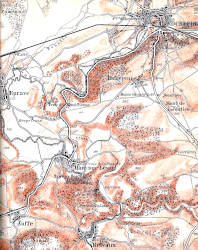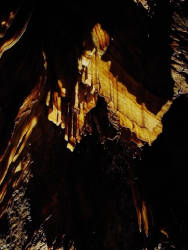Grottes de Han-sur-Lesse
Grottes de Han
Useful Information




| Location: |
Rue Joseph Lamotte 2, 5580 Rochefort.
E411 (Brussels-Luxembourg), exit 23 (Wellin). Han/Lesse is 5 km further. Very well signposted. (50.121246, 5.192347) |
| Open: |
FEB to MAR Sat, Sun 10-16. APR to JUN daily 10-16. JUL to AUG daily 9:30-17:30. SEP to OCT daily 10-16. NOV to DEC Sat, Sun 10-16. School Holidays daily 10-16. For details see online booking. [2023] |
| Fee: |
Adults EUR 27, Children (4-11) EUR 29.50, Children (0-3) free, Disabled EUR 24.30. Groups (20+): Adults EUR 19.15, Children (4-11) EUR 14.65, Children (0-3) free, School Pupils EUR 13.50. [2023] |
| Classification: |
 Karst Cave Karst Cave
 river cave. river cave.
 Historic Show Caves Historic Show Caves
 The Most Expensive Show Cave The Most Expensive Show Cave
|
| Light: |
 LED LED
 Son et Lumière Son et Lumière
|
| Dimension: | L=10,693 m, T=9 °C. |
| Guided tours: |
Cave Discovery:
D=75 min, L=1,300 m, St=365. Cave Journey: D=120 min, L=2,000 m, St=510. V=80.000/a [1912]. V=500.000/a [1995]. V=500,000/a [2000]. V=300,000/a [2019]. |
| Photography: | allowed without flash |
| Accessibility: | no |
| Bibliography: |
Yves Quinif (1999):
Karst and the evolution of rivers: a case study of Ardennes,
Geodinamica Acta, Volume 12, Issues 3–4, May–August 1999, Pages 267-277, ISSN: 0985-3111.
DOI
pdf
 DOI
pdf
DOI
pdf

Anne Court (1968): The Caves of Han and Rochefort The Speleologist, Vol 2, No 14, Winter 1968, pp 8-9. online E. A. Martel (1899): Explorations nouvelles dans le Grotte de Han Ciel et Terre, 1899, vol. 19, pp.468-473 online 
Daniel André (1997): Edouard-Alfred Martel et Les Cavernes de la Belgique, Int. J. Speleol., 26, 3-4 (1997): pp 49-77. pdf |
| Address: |
Grottes de Han et de Rochefort, rue J. Lamotte 2, B-5580 Han/Lesse, Tel: +32-84-377213.
E-mail: |
| As far as we know this information was accurate when it was published (see years in brackets), but may have changed since then. Please check rates and details directly with the companies in question if you need more recent info. |
|
History
| 1743 | Pierre Lambert de Saumery notes that the Lesse took 24 hours to flow through the Boine massif. |
| 1771 | first recorded exploration of the cave by boat. |
| 1814-1817 | exploration of the main passage with the huge chambers. |
| 1818 | Count Robiano tried to find a route through. |
| 1822 | first cave map drawn. |
| 1857 | cave opened as a show cave. |
| MAY-1888 | visited by E. A. Martel. |
| 18 to 20-SEP-1898 | explored by E. A. Martel and Ernest Van den Broek, new map drawn. |
| 01-JUN-1906 | tram opened. |
| DEC-1964 | Guy Deflandre unexpectedly discovered Santa Claus Cave. |
| 1968 | the Belgian diver Daniel Ameye disappeared in the Gouffre de Belvaux. |
| 2009 | boat ride replaced by a bridge. |
| 2017 | show cave reopened after renovation, new light system. |
Description




The Grottes de Han-sur-Lesse is a cave system which forms part of the subterranean river Lesse. The river disappears in the Gouffre de Belvaux and reappears 24 hours later on the other side of the Boine hill at the Trou de Han (Han Hole).
The cave has a huge entrance portal, the Trou de Han, so it was obviously known since prehistoric times. On the other hand, the entrance is the resurgence of the river Lesse and so its necessary to swim to enter the cave, which was probably a drawback for early man. Nevertheless, a few must have ventured into the cave, at the beginning of the sixties, divers discovered an archaeological treasure trove on the riverbed.
The first who scientifically researched the cave was Pierre Lambert de Saumery, a novelist who also became known as an impostor and marriage swindler. He noted in 1743 that the Lesse took 24 hours to flow through the Boine massif. The first time the cave was actually entered was 1771, where a boat was used to enter the lower entrance for some distance. However, little is known about this event, there is no written report and even the year is disputable. The actual exploration of the main passage happened between 1814 and 1817, in 1818 Count Robiano failed to find a route through the cave to the river sink. And finally in 1822 the first cave map was drawn. The cave was opened for tourism in 1857, which makes it one of the oldest show caves and definitely the oldest show cave in Belgium. The 19th century ended with a three-day exploration of the cave by E. A. Martel and Ernest Van den Broek. The map which the two created is now in the public domain, you can see it on the right.
Originally the cave was entered by boat, then there was a tourist trail in the huge chamber, and finally the visitors returned by the boat. The success of the cave continued in the 20th century, massive numbers of visitors, interrupted by two World Wars. The writer George Sand visited the cave and had an episode of a novel set in the cave. The cave was developed with a through-tour to handle the enormous amount of visitors, and reduce the boat trips to one. For this purpose an artificial tunnel was built at the far end of the cave. But this entrance was now on the opposite side of the hill, and it was necessary to follow a long meander of the dry valley to this place. The solution was quite simple and the first non-speleologic attraction of the cave, a tram was built from the village to the new entrance. It is in use until today. From the tunnel the tour follows the side passage to the cave river, then through the main chamber and finally out of the cave with a short boat ride. The latest adaption is an elevated trail along the wall which makes the boats obsolete. It was added in 2009, and while it is a little sad that there is no longer a boat ride, it is also one less possible cause of accidents.
A few more words on the tram. Belgium once had a system of interurban tramways which covered the entire country. The difference to the normal train network is the narrow gauge of 1 m and the use of trams instead of trains. Only three fragments of this system still remain, this is one of them. In general, they were built as public transport infrastructure and the trams were first steam powered until 1935, then replaced by diesel powered trams. The Rochefort-Willen main line was opened in 1904, and the Han-sur-Lesse-Grottes de Han branch added two years later in 1906, always intended to carry tourists from the village to the cave entrance. The network operated, except for the wars, until the 1950s. In 1955 the Rochefort-Willen main line was closed, and for the dismantling works the tram was temporarily substituted by busses. But afterwards the tram to the cave was reopened, and 1968 and 1989 the tracks were optimized for the use by the show cave. The train station for the tram is now right behind the ticket office in the middle of the village, which is quite convenient. The tram has three stops, the ticket office, the cave entrance and the cave exit. The trams which are used today are still those which replaced the steam powered trams in 1935.
The cave has several huge chambers.
The Salle du Dôme (Dome Room) is the largest natural cavity in Belgium, 62 m high, 86 m wide and 149 m long.
During the 1970s the cave had a cave restaurant, an underground restaurant where the visitors could eat and drink.
But the logistics to transport all the material in and out of the cave on boats was probably the main drawback, which made the restaurant unprofitable.
So it was soon discontinued, definitely a good decision from the cave conservation viewpoint.
The place of the restaurant has benches today, where people take a seat to enjoy the
 Son et Lumière.
Son et Lumière.
Originally there was only one single tour, but it seems they have made two tours, the Grotte Découverte (Cave Discovery) and the Grotte Traversée (Cave Journey). As far as we understand, the second is more or less the traditional tour, and the first is shorter with fewer steps, for people who prefer it a bit less sportive.
The cave is a major tourist site and thus well developed. Numerous attractions make it worth a whole day visit. Beneath the caves is the Museum of the Subterranean World with a prestigious collection of archaeological remains discovered in the cave. Then there is a railroad ride, a wildlife reserve and the Expotheme, an exhibition on the Maasai. The cave has three stars in Guide Michelin, and is so proud of it, they never fail to mention it!
- See also
 Search DuckDuckGo for "Grottes de Han"
Search DuckDuckGo for "Grottes de Han" Google Earth Placemark: ticket office
Google Earth Placemark: ticket office Google Earth Placemark: cave entrance
Google Earth Placemark: cave entrance Caves of Han-sur-Lesse - Wikipedia (visited: 07-MAY-2023)
Caves of Han-sur-Lesse - Wikipedia (visited: 07-MAY-2023) Domaine des Grottes de Han, official website (visited: 07-MAY-2023)
Domaine des Grottes de Han, official website (visited: 07-MAY-2023) HAN-SUR-LESSE DIESEL TRAMWAY NETWORK (visited: 07-MAY-2023)
HAN-SUR-LESSE DIESEL TRAMWAY NETWORK (visited: 07-MAY-2023)




 Index
Index Topics
Topics Hierarchical
Hierarchical Countries
Countries Maps
Maps